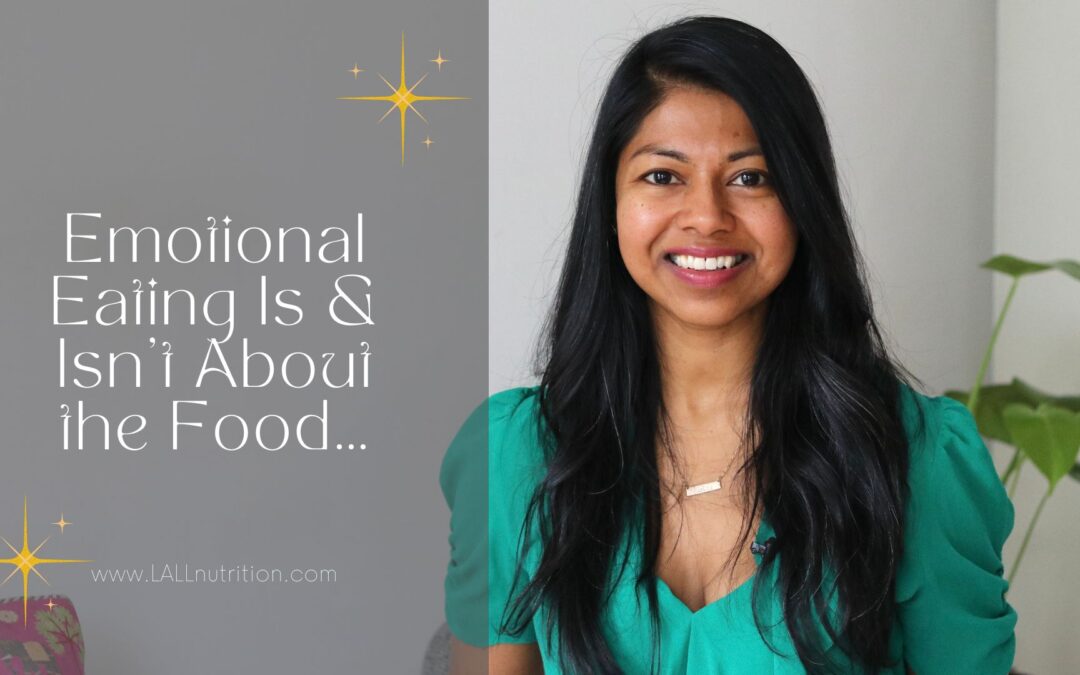I want to share with you why emotional eating is and is not about food. I wanted to to dive a little bit deeper into this topic because when I work with clients, it’s really hard at the beginning for them to see how their emotional eating is not about food and the role food does play.
Usually my clients know there are emotions involved. They know something else is going on under the surface, but it doesn’t feel obvious. What you see on the surface is that you’re going towards food to soothe yourself. Every time you’re triggered, you’re going towards food.
Emotional eating is about the food and it isn’t about the food because we’re using the food to meet a need that it’s not meant to meet.
It can get a little complex so I’m going to try to keep it as simple as possible. Emotional eating is when we use food to soothe ourselves from any comfort or distress.
It seems odd we put the two together, doesn’t it?
If we think about food on its own, food tastes good. When we eat it, we produce feel good chemicals and endorphins in our bodies. Food naturally soothes our system, it calms us. Food is also connected to being breastfed/fed as a baby and love. They come in this little package together.
Food + Mood
Food is important for nourishment but it also helps us physically feel different things.
So you might notice if you eat some foods, you feel irritable after, you feel good, after, you feel calm after, you feel soothed after. Food has qualities to it. In Ayurveda, they emphasize these different qualities of food. So when we’re eating certain foods, they can help promote a more of a calm state in our body (or agitated, etc), which is beautiful to harness – when we’re truly hungry.
We can use these qualities of the food as medicine. We can use it to support us, to comfort us. When it is about hunger, true hunger. But when we use food to soothe ourselves as an emotional eater, we’re not using it to quench physical hunger. It’s an emotional hunger. You can’t use something physical to deal with something emotional, but it does give this temporary relief. Here we are using food as a drug.
When we use food to soothe ourselves, it’s very temporary. This is why it’s a bandaid solution. This is also why emotional eating isn’t really about the food. But as you can see, food does give us these amazing qualities. So when we use food, we’re using the qualities of the food as a bandaid to give us some sense of comfort or soothing that substitutes for the needs we long for.
The Roots of Emotional Eating
Emotional Eating is a pattern that I see when I work with clients that has roots in childhood when certain needs were not met. Food is a way to to soothe oneself, to provide comfort, and to take the edge off.
What happens is that parents/caregivers/those close to us don’t model how to be with emotions. But more importantly, they don’t know how to hold that space for us to regulate ourselves when we’re feeling uncomfortable emotions or discomfort. They are not able to help guide us to find resolution which results in discomfort and trauma. Developmentally we need this modelling and space holding.
What happens is quite the opposite. We’re shamed for our emotions. In our society, we dismiss emotions, we think something’s wrong with us, we’re weak, we’re too sensitive, and all these labels get put on us.
So we feel a lot of shame, but we are still feeling that discomfort internally. So we start using food to soothe ourselves. Or we might have actually been given food to soothe ourselves. Or we might have seen our parents or caregivers use it.
When we eat processed foods, we get a bigger bang for our buck. So we’re getting more of a dopamine hit and so we crave that hit, that feeling good when we’re not feeling good.
The Coping Mechanism
Our brain might think, “oh, I’m not in a good mood. I don’t know how to actually move through this. I was modelled this and so this food, this thing felt good.” We figure food gives us this dopamine rush and if you’re here as an emotional eater, you’re using food to do that for yourself.
So every time you get triggered into a certain mood or an emotional trigger comes up, your brain just goes, “okay, time to eat food”. That’s how we deal with this. But it’s not getting into the root.
How to move through this…
We need to learn how to get to the root. It’s not as easy as just saying “feel your emotions. What do you truly need?”
Sometimes programs give you suggestions and make you think “this” is your need. But when I work with clients, we find their specific needs. It’s going to be a bit different and unique to each person.
With all my clients there is a similar flavour of their needs not being met in terms of not being seen, heard, validated, accepted, loved, etc.
They were not able to move through their discomfort or unresolved emotion. This is where we need to go a deeper and this is why I love doing the somatic meditations with clients with psychotherapy tools. This is a huge part of The Emotional Eating Evolution Program.
We also need to be building the structure and foundation around our relationship to food, our body and our emotions. Because even though at the root of emotional eating is about unmet needs we have now created a dysfunctional relationship to food (+ our body) that feeds into this pattern.
Emotional eating is not about the food, but it is about the food. Because when we use food as a coping mechanism, that means our relationship to food is not quite healthy. We need to rebuild that relationship to food and then not use it as a band aid. But we’re also rebuilding our relationship to food, our body and our emotions in order to resolve the pattern.
So that once we have this healthy relationship to food, it can take its rightful place in our life.
Invitation: If this is resonating for you, I’d love to invite you to check out more about The Emotional Eating Evolution Program HERE. It’s my step by step methodology with lots of support, guidance and somatic meditations to go deeper into the roots of your emotional eating pattern, to clear it and dissolve it so that you start feeling at ease in your body and around food.
To feeling at ease around food and in your body,
Michelle
Certified Holistic Nutritionist + Emotional Eating Expert.


